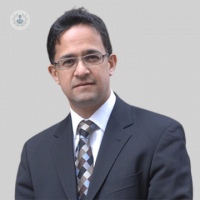Mid-facelift: target the earliest signs of ageing
Written in association with:For many people, the lower eyelids and cheeks are their biggest problem of facial ageing. A traditional facelift might not entirely treat the upper cheek and lower eyelid areas of the face, so they might opt to have a mid-facelift. Mr Jonathan Britto, a prestigious craniofacial plastic surgeon based in London, explains what a composite mid-facelift is and what happens during the procedure.

What is a mid-facelift?
As the cheeks below the lower eyelids droop with age, and the lower eyelids lose their tone and become baggy, a deep groove develops along a line between the lower eyelid and the cheek, often called a tear-trough at the nose extending to the malar crescent between the eyelid and the cheek. The cheek sags so that a fold also develops between the nose and the corner of the mouth along a line called the nasolabial fold.
Midface lifts try to address these problems by lifting this mid portion of the face to restore the youthful continuity between the lower eyelid and cheek. Midface lifts can be performed at different levels in the face depending on the ageing process and indication. The results are often very rejuvenating - by banishing the shadow, and the ‘ski-slope contour’ of the lower eyelid and midface and introducing the reflection of light with a smooth natural and youthful curve.
Midface lifts are also used in reconstructive craniofacial surgery to correct problems from conventional lower eyelid blepharoplasty surgery when the lower eyelid might be pulled down. The midface lift elevates the cheek to support the eyelid, and where there is inadequate cheek bone support, can be combined with cheek implants. The analysis before surgery, therefore, is to assess the position of the cheek bone, the laxity of the cheek soft tissues, and the contour and function of the lower eyelid.
In having to assess and plan for the position of the cheekbone, the laxity of the cheek, and the aesthetics and function of the lower eyelid all together, composite midface lifts are more complex procedures than conventional facelifts but need not have a longer recovery time.
Who is likely to opt to have the procedure?
The following are most likely to benefit from midface lifting:
- People with significant lower eyelid ageing and a droopy cheek
- Those with poor bone support of the eyelids
- Those with eyelids that have been pulled too low by traditional lower blepharoplasty
Many people will benefit from a combination of a mid-facelift and traditional facelift techniques. However, the patient must understand that there’s a much longer recovery time from midface lifting, which usually takes several months.
What happens during the procedure?
Midface lifts are most often be done using incisions under the eyelash line in the lower eyelid similar to those of lower blepharoplasty. Some types of midface lift can also be done by making incisions in the hair of the temple region running down to the creases in front of the ear.
Via the eyelash line scar, every layer of the face between skin and the bone can be lifted in relation to the layer below, off the bone itself, and secured in a robust and effective way. With the temporal and pre-curricular scar, the more superficial layers of the face are elevated – and this may be all that is required to achieve the final results, which is to banish the shadow from the face and introduce the reflection of light. The composite midface lift will also reduce the elongated vertical height of the lower eyelid with age, and will reshape the middle third of the face.
How long does it last?
Composite midface lift and blepharoplasty is a powerful combined procedure that is lifted from and anchored to the underlying bone. It is a very stable composite lower eyelid and cheek surgical procedure. When undertaken properly, the surgery will reverse and slow the effects down natural facial ageing in the midface with a result that lasts for many years.
If you are considering a mid-facelift, visit Mr Jonathan Britto’s profile and book a consultation via the website.


